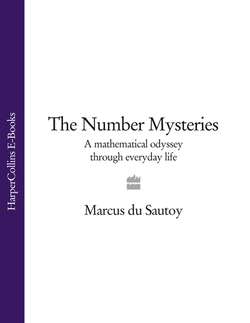Читать книгу The Number Mysteries: A Mathematical Odyssey through Everyday Life - Marcus Sautoy du - Страница 16
Which prime is this?
ОглавлениеFIGURE 1.14
Although these are letters rather than numbers, this is how to write the number 13 in Hebrew. In the Jewish tradition of gematria, the letters in the Hebrew alphabet all have a numerical value. Here, gimel is the third letter in the alphabet and yodh is the tenth. So this combination of letters represents the number 13. Table 1.01 details the numerical values of all the letters.
People who are versed in the Kabala enjoy playing games with the numerical values of different words and seeing their inter-relation. For example, my first name has the numerical value
which has the same numerical value as ‘man of fame’ … or alternatively, ‘asses’. One explanation for 666 being the number of the beast is that it corresponds to the numerical value of Nero, one of the most evil Roman emperors.
TABLE 1.01
You can calculate the value of your name by adding up the numerical values in Table 1.01. To find other words that have the same numerical value as your name, visit http://bit.ly/Heidrick or use your smartphone to scan this code.
Although primes were not significant in Hebrew culture, related numbers were. Take a number and look at all the numbers which divide into it (excluding the number itself) without leaving a remainder. If when you add up all these divisors you get the number you started with, then the number is called a perfect number. The first perfect number is 6. Apart from the number 6, the numbers that divide it are 1, 2 and 3. Add these together, 1+2+3, and you get 6 again. The next perfect number is 28. The divisors of 28 are 1, 2, 4, 7 and 14, which add up to 28. According to the Jewish religion the world was constructed in 6 days, and the lunar month used by the Jewish calendar was 28 days. This led to a belief in Jewish culture that perfect numbers had special significance.
The mathematical and religious properties of these perfect numbers were also picked up by Christian commentators. St Augustine (354–430) wrote in his famous text the City of God that ‘Six is a number perfect in itself, and not because God created all things in six days; rather, the converse is true. God created all things in six days because the number is perfect.’
Intriguingly, there are primes hidden behind these perfect numbers. Each perfect number corresponds to a special sort of prime number called a Mersenne prime (more of which later in the chapter). To date, we know only 47 perfect numbers. The biggest has 25,956,377 digits. Perfect numbers which are even are always of the form 2n–1(2n–1). And whenever 2n–1(2n–1) is perfect, then 2n–1 will be a prime number, and conversely. We don’t yet know whether there can be odd perfect numbers.
